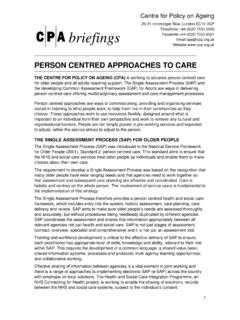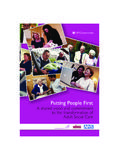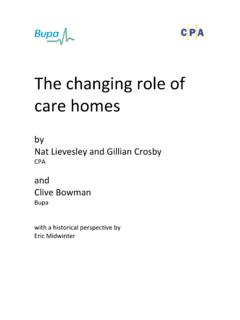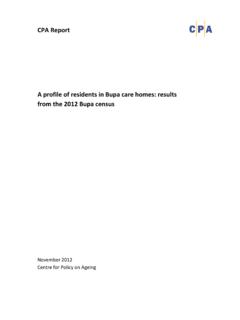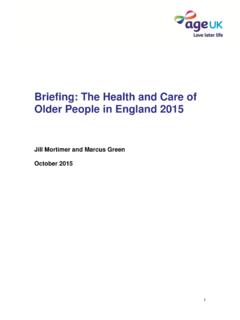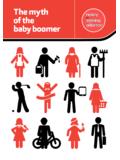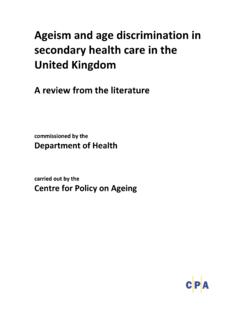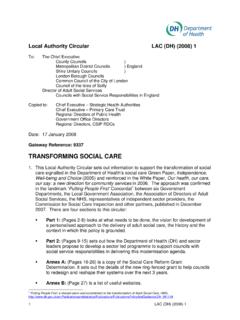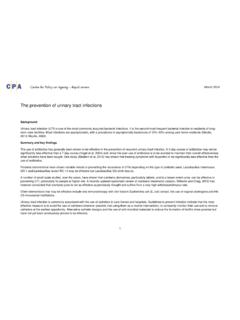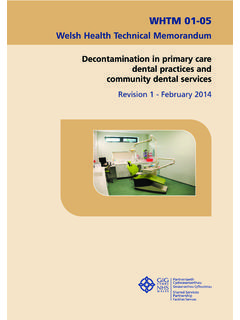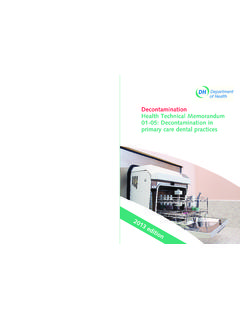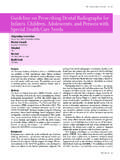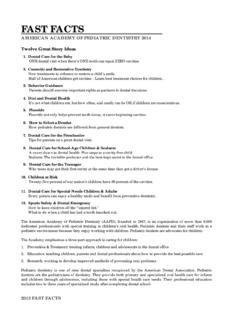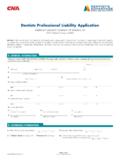Transcription of A review from the literature - CPA
1 Ageism and age discrimination in primary and community health care in the United Kingdom a review from the literature commissioned by the Department of Health carried out by the Centre for Policy on Ageing Ageing, in all its complexity, is a central issue in human health and disease, and cannot be addressed as an afterthought. (Lamb 2002) Centre for Policy on Ageing December 2009 Initial review period: February April 2009 Revised and updated: May November 2009 Principal author: Angela Clark review team: Ruth Hayes Kate Jones Nat Lievesley Director: Gillian Crosby 2009 Centre for Policy on Ageing Disclaimer: The views in this report are those of the authors and do not necessarily represent the views of the Department of Health. 3 Contents 1 Introduction 5 Purpose of the review 5 Government policies to support older people 7 primary health care 8 Ageing population and health 8 Ageism and age discrimination in health care 10 Equality Bill 11 Identifying age discrimination 11 2 Ageist attitudes 13 3 NSF for Older People 15 4 Access to GP services 17 Physical access 17 Making appointments 18 Time with the GP 19 Out of hours services 20 Older people living in care homes 20 Policies to improve access 22 5 Evidence of ageism and age discrimination in GP practice 24 Treatment and quality of care 24 Overview 25 Cancer 27 Cardiovascular disease 28 Heart failure 29 Osteoporosis 30 Continence 30
2 Parkinson s disease 32 Diabetes 32 6 GP referrals 34 7 Preventative strategies 36 Vascular disease 36 4 Falls prevention 39 Health promotion 40 Screening 42 8 Frail older people and multimorbidity 44 9 Prescribing rates and polypharmacy 46 10 Rehabilitation services 47 11 Palliative care 50 12 Dental care 51 13 Eye care services 53 14 Foot care services 55 15 Hearing services 56 16 GP Performance Contract 57 17 NICE guidelines and the use of QALYs 60 18 Focus of the NHS 62 19 Conclusion 64 Evidence of discrimination in policies and practice 65 Evidence of discrimination in systems and structures 66 Evidence of discrimination in resources 67 Evidence of discrimination in health promotion and ageing well 67 Future research 68 20 References 70 Appendix 1 Methods Appendix 2 Bibliography This review is one of four reviews of ageism and age discrimination in health and social care available from 5 1.
3 Introduction Purpose of the review The Department of Health (DH) commissioned the Centre for Policy on Ageing (CPA) to identify possible evidence of age discrimination in policy and practice in primary health care in the UK through a review from the literature . The remit for the review of primary care services was to signpost areas where negative discrimination may be occurring for service commissioners and providers to use as a starting point in reviewing and revising their practice. Evidence from the review of primary care will support DH s activities to root out age discrimination in the context of the European Commission Draft Directive (July 2008) COM (2008) 426 and the introduction in the UK Parliament of the Equality Bill (April 2009) and related secondary legislation that will set out details of the new age discrimination ban in the provision of goods and services. It informed the national review on age discrimination led from the South West region by Sir Ian Carruthers, Chief Executive of the South West Strategic Health Authority, and Jan Ormondroyd, Chief Executive of Bristol City Council.
4 The national review produced a report in October 2009 with recommendations on the timing of implementation of the ban and on those areas of age based differentiation that should be maintained under the new law (Carruthers and Ormondroyd 2009). The DH commissioned CPA to undertake separate reviews from the literature to provide evidence of ageism and age discrimination in social care , secondary health care and mental health services. The four reviews are rapid semi systematic literature reviews and not systematic reviews. Each review was conducted over a period of ten weeks. While it is acknowledged that age discrimination can apply to all ages, this report on primary care , and the CPA reviews mentioned above, focus primarily on the experiences of older people. Issues around multiple discrimination, gender and minority ethnic groups are not singled out for special attention but are discussed within individual studies.
5 Mental health services, including dementia care , are specifically outside the remit of this review of primary care . It should be noted that mental health services, organised as separate services for younger and older people, can be viewed as an example of systemic age discrimination as older people do not have access to the range of services available to younger adults despite having the same, and often greater, need (Royal College of Psychiatrists 2007, policy document). This is supported by a finding from an audit of mental health services in which older people reported a noticeable difference in their experience of accessing appropriate services as they reached and passed the age of 65 (Healthcare Commission et al 2006, study). 6 This review of primary health care does not provide an economic or cost benefit analysis of the removal of age discrimination in primary health services but does provide a starting point for such an analysis.
6 Also it does not provide a critical and evaluative study of the nature and cause of discrimination in the health services set within a wider societal and cultural context, although reference is made to the presence and impact of health care professionals ageist attitudes. The studies considered in this review of primary care are from within the UK, except where findings have wider applicability, for example in the case of under representation of older people in drug trials. Reviews from the literature have their limitations. In order to fulfil the DH s remit, because of the paucity of systematic research on age related inequalities in primary care , it was necessary to scrutinise literature focusing on treatments for individual conditions, services and practices following a citation trail in an effort to unearth evidence of possible discrimination from patterns of differential access, referral and treatment (see methodology in appendix 1).
7 It is not always possible to establish the reasons for differentiation where it occurs, although discrimination based on age may be a factor. We have been constrained by the studies addressing issues around age discrimination that have been carried out to date, the ability to search and find evidence in such a disparate and extensive literature within the given time frame and obviously the varied approach of each study. Although search processes have been rigorous, inevitably some relevant literature may have been overlooked. To make it easier to assess the nature and weight of the evidence presented in this report we have, split the sources of the evidence into a small number of simple categories. Category labels have been added to the reference citations in the body of the text to provide an at a glance first indication of the weight of the evidence. Large survey Sample survey of 800+ from a large population Survey Sample survey of 120 800 from a large population or 50%+ from a small population.
8 We will use the generic term survey to include retrospective case audits. Small survey Sample survey of less than 120 from a large population or less than 50% of a small population Group study Focus group, panel or equivalent study Study Individual research project, observational study or analysis not carried out as a group study or survey Opinion Opinion of a respected authority, editorial etc. Systematic review Systematic review , with or without meta analysis 7 review literature and other reviews not structured as a systematic review Policy document Government or professional overview Campaign document Document to promote a particular point of view Guide Guide, information pack or toolkit Government policies to support older people This review of primary care is part of a continuing process of developmental work comprising government research, strategies and initiatives that are designed to improve outcomes for older people and act as levers for tackling inequalities in services.
9 Activities include the National Service Framework for Older People (NSFOP) (DH 2001); the cross government strategies on ageing Opportunity Age (2005) and Building a Society for All Ages (2009); the Dignity in care campaign (2006); the End of Life care strategy (2008); and the National Dementia Strategy (2009). The Prevention Package (PP) for Older People, launched as part of Building a Society for All Ages, prioritises better preventive care for older people and a renewed focus within the NHS at local level to work in partnership with social care , local authorities and older people. It encompasses a new focus on innovative healthcare, such as telecare; better services for falls, fractures and osteoporosis; a review of foot care services; and an ongoing commitment to reduce waiting times for hearing tests and the fitting of aids. Existing preventive measures cover flu vaccination, cancer screening, abdominal aortic aneurysm (AAA) screening, eye checks and vascular checks.
10 A refresh of Intermediate care guidance is also included in the strategy. Interim reports evaluating the Partnerships for Older People projects (POPPs) have provided some evidence that care initiatives that focus on early interventions can have a positive impact on people s health. The underlying aim of the 29 pilot sites is to create a sustainable shift in resources and culture away from the focus on institutional and hospital based crisis care toward earlier and better targeted interventions for older people within community settings. In the longer term, the findings from the NE will contribute to the evidence on effectiveness of initiatives aimed at promoting independence, prevention and early intervention as highlighted in the White Paper Our Health, Our care , Our Say: A new direction for community services and more recently in Putting People First Transforming Adult Social care (Windle et al 2008, study).
